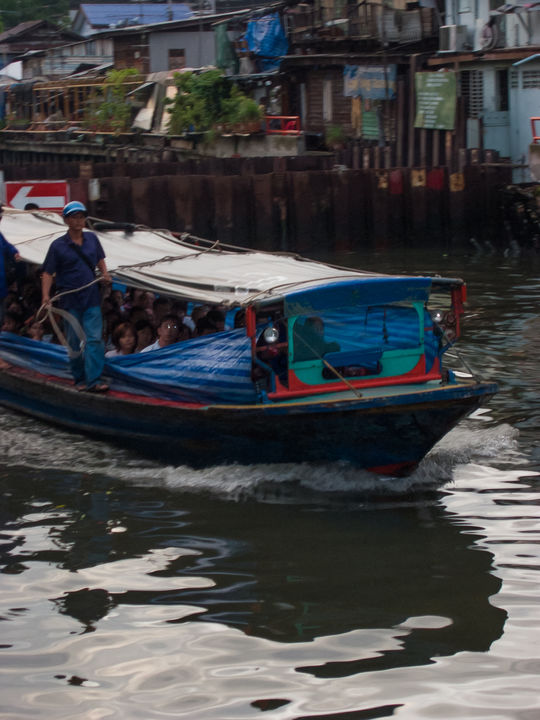Khlong Saen Saep
Bangkok, Thailand
Bangkok may lead the world in anarchically informal ways to get around. Like any other self-respecting Asian town, it is infested with tuk-tuks, three-wheeler taxis that skitter through the gridlocked traffic like gaily-colored bugs. There are buses of every size and color, usually doorless to allow passengers to get on and off as rapidly as possible. There are long-tail boats - narrow canoe-like vessels with a VW engine mounted on gimbals in the stern driving a screw at the end of a fifteen-foot shaft that makes a noise like a buzz saw and raises a rooster-tail of white water behind it - to take you across the river. There are taxis, with and without meters. There are motorcycle taxis. There are tricycle rickshaws. There is a Skytrain and a River Express. There will soon be an underground.
And there is the Khlong Saen Saep boat, which may be the only public transport system in the world that runs on toxic waste.
If the word 'canal' conjures up a mental image of a limpid, tranquil waterway lined with languid gondolas and stately palaces, think again. Like most of Bangkok's khlongs, Khlong Saen Saep is liquid filth, a narrow line of poisonous black water stretched across the map of the city. Old houses crowd down to the water's edge. Walking beside the canal, you step over the shoes set outside people's doors and find yourself peering into their kitchens at every second step.
The boats that run on Bangkok's navigable canals are about thirty or forty feet long, seating five or six passengers abreast at the widest point. There is no central aisle or gangplank. As the boat pulls up to the rickety wooden landing stage – with its complement of spectacularly mangy dogs – the helmeted crew members jump ashore with ropes in their hand to make it temporarily fast to the jetty. The alighting passengers are already standing on the gunwales, ready to jump off in the fifteen or twenty seconds that the boat stays at the stage.
To board the boat, you step quickly off the landing stage and onto the gunwale, grabbing for the rope that runs around the roof of the boat with all the hands you can spare. You then walk along the side of the boat until you see an empty seat, at which point you climb in and down, stepping over the blue-and-white plastic spray sheets that run along both sides of the passenger area. It's generally advisable to try to reach a seat before the boat takes off, so that you don't end up clinging to the side with the crew, but this isn't always easy when the boat is crowded.
The boats move surprisingly fast in the narrow space of the canal, slaloming among the various obstacles in their way - bridge piers, jetties, breakwaters made of corrugated iron, other boats coming in the opposite direction. When the canal is full, there is very little clearance between the top of the boat and some of the bridges – there's a reason that the deckhands all wear helmets. The canvas tilt over the passenger seating is mounted on jointed stanchions that allow it to be pulled downwards until it touches the heads of the taller passengers, giving just enough room for the boat to scoot under the bridge.
The whole thing feels like a funhouse ride adapted for commuter transport by a sadistic urban planner. In any city in the first world, the insurance premiums necessary to protect the operators against lawsuits for dropping passengers and employees in the stinking black waters of the khlong or beaning them with a bridge would make it instantly uneconomical either to run or to use. In Bangkok, it's all part of a day's journey to work.
